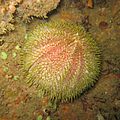
Temnopleuridea is an infraorder of sea urchins in the order Camarodonta. They are distinguished from other sea urchins by the presence of large fused plates on top of the feeding lantern. The test is usually sculpted to some degree, and has perforated tubercles.

The Salenioida are an order of sea urchins.

The Echinacea are a superorder of sea urchins. They are distinguished by the presence of a rigid test, with ten buccal plates around the mouth, and solid spines. Unlike some other sea urchins, they also possess gills. The group is a large one, with species found worldwide.

The Echinothurioida are an order of sea urchins in the class Echinoidea. Echinothurioids are distinguished from other sea urchins by the combination of a flexible test and hollow spines. The membrane around the mouth contains only simple plates, in contrast to the more complex mouth parts of their close relatives, the Diadematoida. They are nearly all deepsea dwellers.

Cidaroida is an order of primitive sea urchins, the only living order of the subclass Perischoechinoidea. All other orders of this subclass, which were even more primitive than the living forms, became extinct during the Mesozoic.

Toxopneustes pileolus, commonly known as the flower urchin, is a widespread and commonly encountered species of sea urchin from the Indo-West Pacific. It is considered highly dangerous, as it is capable of delivering extremely painful and medically significant stings when touched. It inhabits coral reefs, seagrass beds, and rocky or sandy environments at depths of up to 90 m (295 ft). It feeds on algae, bryozoans, and organic detritus.
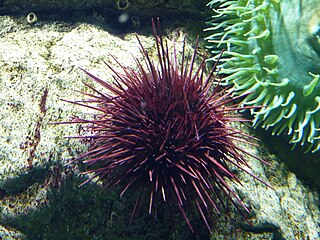
The Parechinidae are a family of sea urchins in the class Echinoidea.

Toxopneustidae is a family of globular sea urchins in the class Echinoidea.

Echinidae is a family of sea urchins in the order Echinoida. Members of the family are found in the Atlantic Ocean and the Antarctic.

Sterechinus is a genus of sea urchins in the family Echinidae. All living members of the genus are found in the waters around Antarctica but the first species described in the genus was a fossil and was found in Europe.
Amphipneustes bifidus is a species of sea urchin of the family Temnopleuridae. Their armour is covered with spines. It is placed in the genus Amphipneustes and lives in the sea. Amphipneustes bifidus was first scientifically described in 1950 by Ole Mortensen, a Danish scientist.
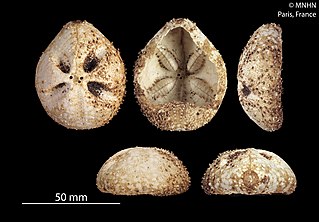
Amphipneustes davidi is a species of sea urchin of the family Temnopleuridae. Their armour is covered with spines. It is placed in the genus Amphipneustes and lives in the sea. Amphipneustes davidi was first scientifically described in 2010 by Madon-Senez.
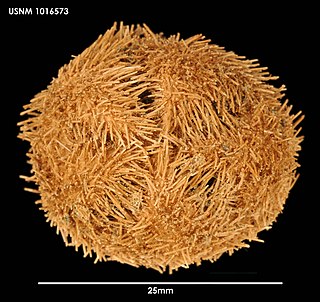
Amphipneustes koehleri is a species of sea urchin of the family Temnopleuridae. Their armour is covered with spines. It is placed in the genus Amphipneustes and lives in the sea. Amphipneustes koehleri was first scientifically described in 1905 by Ole Mortensen.

Amphipneustes marsupialis is a species of sea urchin of the family Temnopleuridae. Their armour is covered with spines. It is placed in the genus Amphipneustes and lives in the sea. Amphipneustes marsupialis was first scientifically described in 1926 by Koehler.
Amphipneustes tumescens is a species of sea urchin of the family Temnopleuridae. Their armour is covered with spines. It is placed in the genus Amphipneustes and lives in the sea. Amphipneustes tumescens was first scientifically described in 1926 by Koehler.
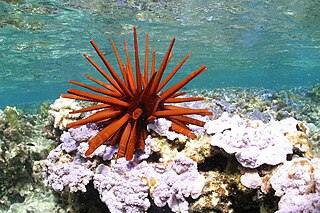
The Echinometridae are a family of sea urchins in the class Echinoidea.
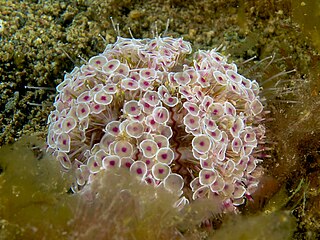
Toxopneustes is a genus of sea urchins from the tropical Indo-Pacific. It contains four species. They are known to possess medically significant venom to humans on their pedicellariae. They are sometimes collectively known as flower urchins, after the most widespread and most commonly encountered species in the genus, the flower urchin. Species included in the genus are the following:

The Echinothuriidae are a family of sea urchins in the order Echinothurioida. Due to their soft skeletons, most are called "leather urchins", but species in the genus Asthenosoma are also known as "fire urchins" due to their bright colors and painful, venomous sting.

Toxopneustes maculatus is a rare species of sea urchin found in the Indo-West Pacific.

Gracilechinus is a genus of sea urchins in the family Echinidae.

